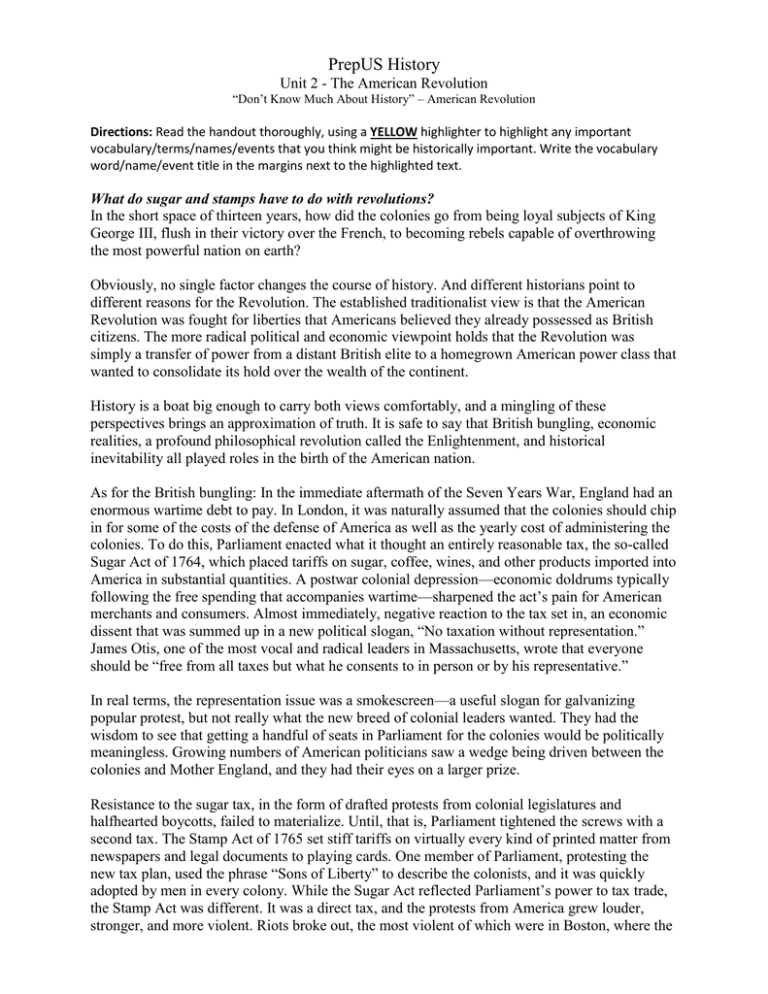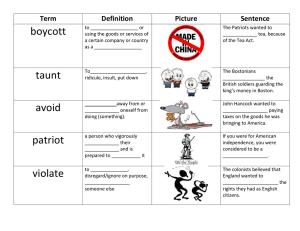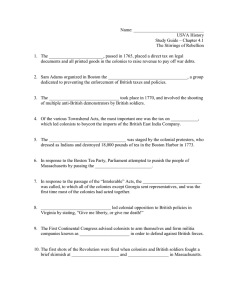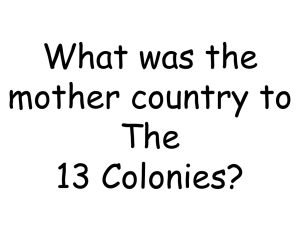PrepUS History Unit 2 - The American Revolution
advertisement

PrepUS History Unit 2 - The American Revolution “Don’t Know Much About History” – American Revolution Directions: Read the handout thoroughly, using a YELLOW highlighter to highlight any important vocabulary/terms/names/events that you think might be historically important. Write the vocabulary word/name/event title in the margins next to the highlighted text. What do sugar and stamps have to do with revolutions? In the short space of thirteen years, how did the colonies go from being loyal subjects of King George III, flush in their victory over the French, to becoming rebels capable of overthrowing the most powerful nation on earth? Obviously, no single factor changes the course of history. And different historians point to different reasons for the Revolution. The established traditionalist view is that the American Revolution was fought for liberties that Americans believed they already possessed as British citizens. The more radical political and economic viewpoint holds that the Revolution was simply a transfer of power from a distant British elite to a homegrown American power class that wanted to consolidate its hold over the wealth of the continent. History is a boat big enough to carry both views comfortably, and a mingling of these perspectives brings an approximation of truth. It is safe to say that British bungling, economic realities, a profound philosophical revolution called the Enlightenment, and historical inevitability all played roles in the birth of the American nation. As for the British bungling: In the immediate aftermath of the Seven Years War, England had an enormous wartime debt to pay. In London, it was naturally assumed that the colonies should chip in for some of the costs of the defense of America as well as the yearly cost of administering the colonies. To do this, Parliament enacted what it thought an entirely reasonable tax, the so-called Sugar Act of 1764, which placed tariffs on sugar, coffee, wines, and other products imported into America in substantial quantities. A postwar colonial depression—economic doldrums typically following the free spending that accompanies wartime—sharpened the act’s pain for American merchants and consumers. Almost immediately, negative reaction to the tax set in, an economic dissent that was summed up in a new political slogan, “No taxation without representation.” James Otis, one of the most vocal and radical leaders in Massachusetts, wrote that everyone should be “free from all taxes but what he consents to in person or by his representative.” In real terms, the representation issue was a smokescreen—a useful slogan for galvanizing popular protest, but not really what the new breed of colonial leaders wanted. They had the wisdom to see that getting a handful of seats in Parliament for the colonies would be politically meaningless. Growing numbers of American politicians saw a wedge being driven between the colonies and Mother England, and they had their eyes on a larger prize. Resistance to the sugar tax, in the form of drafted protests from colonial legislatures and halfhearted boycotts, failed to materialize. Until, that is, Parliament tightened the screws with a second tax. The Stamp Act of 1765 set stiff tariffs on virtually every kind of printed matter from newspapers and legal documents to playing cards. One member of Parliament, protesting the new tax plan, used the phrase “Sons of Liberty” to describe the colonists, and it was quickly adopted by men in every colony. While the Sugar Act reflected Parliament’s power to tax trade, the Stamp Act was different. It was a direct tax, and the protests from America grew louder, stronger, and more violent. Riots broke out, the most violent of which were in Boston, where the house of Governor Thomas Hutchinson was destroyed by an angry mob. In New York, the home of the officer in charge of the stamps was also ransacked. A boycott of the stamps, widely joined throughout the colonies, was followed by a general boycott of English goods. Hit hard by the economic warfare, London’s merchants screamed, and the law was repealed in 1766. But it was a case of closing the barn door after the horses had scattered. In America, forces were gathering that most London politicos, ignorant of American ways, were too smug to acknowledge. What was the Boston Massacre? Having been kicked once by the colonial mule, Parliament failed to grasp the message of the Stamp Act boycott, and in 1767 thought up a new set of incendiary taxes called the Townshend Acts, once again placing itself directly behind the mule’s hind legs. Once again, an American boycott cut imports from England in half. The British answer to the Americans’ protest was a typical superpower response— they sent in troops. Soon there were 4,000 British redcoats in Boston, a city of 16,000 and a hotbed of colonial protest. These troops, however, did not just idly stand guard over the populace. In a town already hard-pressed for jobs, the British soldiers competed for work with the laborers of Boston’s waterfront. Early in March 1770, a group of ropemakers fought with a detachment of soldiers who were taking their jobs, and all around Boston, angry encounters between soldiers and citizens became more frequent. Tensions mounted until March 5, when a mob, many of them hard-drinking waterfront workers, confronted a detachment of nine British soldiers. The scene turned ugly as snow and ice, mixed with stones, began to fly in the direction of the soldiers. Confronted by a taunting mob calling for their blood, the soldiers grew understandably nervous. It took only the word “fire,” most likely yelled by one of the crowd, to ignite the situation. The soldiers shot, and five bodies fell. The first to die was Crispus Attucks, the son of an African father and a Massachusetts Natick Indian mother, a former slave who had gone to sea for twenty years to escape slavery. It did not take long for the propagandists, Samuel Adams chief among them, to seize the moment. Within days the incident had become the Boston Massacre, and the dead were martyred. An engraving of the shootings made by Henry Pelham, a half-brother of the painter John Copley, was “borrowed” by silversmith Paul Revere, whose own engraving of the incident got to the printer first and soon became a patriotic icon. As many as 10,000 marched at the funeral procession (out of Boston’s population of 16,000). In the wake of the killings, British troops were withdrawn from the city. With the Townshend Acts repealed (coincidentally on the day of the Massacre), a period of relative calm followed the Massacre and the trial of the soldiers—defended by John Adams, who wanted to ensure fairness—most were acquitted and two were branded and discharged— but it was an uneasy truce at best. What was the Boston Tea Party about? In the thick of the 1988 presidential election campaign, candidate George Bush made Boston Harbor an issue that badly hurt his opponent, Michael Dukakis. Bush made political hay out of the fact that the harbor was an ecological disaster zone, and placed the blame squarely in the lap of Dukakis, the Massachusetts governor. Once before, the mess in that harbor played a role in history, and back then the results were quite extraordinary. If George Bush thought Boston Harbor was a mess in 1988, he should have seen it in 1773. 2 The post-Massacre peace and the end of the nonimportation boycott brought renewed prosperity to the colonies and with it a respite from the bickering with London. Fearing this calm would soften resistance, Samuel Adams and his allies tried to fan the embers over such local issues as moving the Massachusetts assembly out of Boston and who should pay the governor’s salary. These were important legal questions, but not the sort of outrages that inspire violent overthrow of the government. Things heated up considerably when a party of patriots in Rhode Island boarded and burned the Gaspee, a grounded Royal Navy boat intensely disliked for its antismuggling patrols. While the Gaspee arsonists avoided arrest, the British Crown threatened to bring the guilty to England for trial, rebuffing the English tradition of right to trial by a community jury. It was the bit of tinder that Samuel Adams needed to stoke the flames a little higher. In Virginia, the House of Burgesses appointed Patrick Henry, Thomas Jefferson, and Richard Henry Lee as a Committee of Correspondence, and by 1774, twelve of the colonies had such committees to maintain a flow of information among like-minded colonists. But a burning—or boiling—issue was still lacking until Samuel Adams found one in tea. In 1773, Parliament had granted a legal monopoly on tea shipment to America to the nearly bankrupt East India Company. The injury was made worse by the insult of funneling the tea business through selected loyalist merchants, including the sons of Governor Hutchinson of Massachusetts. The East India Company could now undercut American merchants, even those using smugglers, on the sale of tea. Tea first, thought the colonists, what will be next? In November 1773, three tea-laden cargo ships reached Boston. Led by Samuel Adams and a powerful ally, John Hancock, one of the richest men in America and one of those most threatened by the possibility of London-granted trade monopolies, the patriots vowed that the tea would not be landed. Governor Hutchinson, whose sons stood to profit by its landing, put his back up. After two months of haggling, the Boston patriots made up their minds to turn Boston Harbor into a teapot. On the night of December 16, 1773, about 150 men from all layers of Boston’s economy, masters and apprentices side by side, blackened their faces with burnt cork, dressed as Mohawk Indians, and boarded the three ships. Once aboard, they requested and received the keys to the ships’ holds, as their target was the tea alone and not the ships or any other cargo aboard. Watched by a large crowd, as well as the Royal Navy, the men worked for nearly three hours, hatcheting open the cases of tea and dumping it into the harbor. So much was dumped that the tea soon piled up in the waters and spilled back onto the decks, where it was shoveled back into the water. The Boston Tea Party, as it was quickly anointed, was soon followed by similar tea parties in other colonies and served to harden lines, both in America and England. Patriots became more daring; loyalist Tories became more loyal; Parliament stiffened its back. The Sons of Liberty had slapped London’s face with a kid glove. The king responded with an iron fist. “The die is now cast,” King George told his prime minister, Lord North. “The colonies must either submit or triumph.” What was the First Continental Congress? Who chose its members, who were they, and what did they do? From the moment the tea was dumped, the road to revolution was a short one. In a post–Tea Party fervor, Parliament passed a series of bills, called the Coercive Acts, the first of which was 3 the Port Bill, aimed at closing down Boston until the dumped tea was paid for. It was followed by the Administration of Justice Act, the Massachusetts Regulating Act (which virtually nullified the colony’s charter), and the Quebec Act, establishing a centralized system of government in Canada and extending the borders of Canada south to the Ohio River. Parliament backed up these acts by sending General Thomas Gage to Boston as the new governor, along with 4,000 troops. In addition, it reinforced provisions of the Quartering Act, which gave the army the right to demand food and shelter from colonists. In response to these Intolerable Acts, as the colonists called them, the colonial assemblies agreed to an intercolonial meeting, and each assembly selected a group of delegates. Gathering in Philadelphia from September 5 to October 26, 1774, the First Continental Congress was made up of fifty-six delegates from every colony but Georgia. They represented the full spectrum of thought in the colonies, from moderates and conservatives like New York’s John Jay or Pennsylvania’s Joseph Galloway, who were searching for a compromise that would maintain ties with England, to fiery rebels like Samuel Adams and Patrick Henry of Virginia (Thomas Jefferson was not selected to make the trip). As they gathered, John Adams privately worried, “We have not men fit for the times. We are deficient in genius, in education, in travel, in fortune—in everything.” But his opinion would soon change as the debate began, and Adams became aware that he was indeed in remarkable company. The first Congress moved cautiously, but ultimately adopted a resolution that opposed the Coercive Acts, created an association to boycott British goods, and passed ten resolutions enumerating the rights of the colonists and their assemblies. Taxes and representation were only part of the issue, as Theodore Draper writes in A Struggle for Power. “The struggle to deprive Parliament of its power over taxation struck at the heart of British power in the Colonies and spilled over everything else.” Before adjourning, they provided for a second session to meet if their grievances had not been corrected by the British. While they had not yet declared for independence, the First Congress had taken a more or less unalterable step in that direction. In a very real sense, the Revolution had begun. It needed only for the shooting to start. NOW - go back through the reading and use a DIFFERENT COLORED highlighter to highlight the portion of the text that answers each of questions below, marking the text with the question number. If you already highlighted the text that answers a question in yellow, just write the question number in the margin next to it (you do not need to highlight it again in the other color). What do sugar and stamps have to do with revolutions? 1. Why did the British pass the Sugar Act of 1764? 2. How did the Stamp Act of 1765 differ from the Sugar Act of 1764? 4 What was the Boston Massacre? 3. Why did the working-class men of Boston hate British soldiers so much? 4. Was this event called the Boston “Massacre?” What was the Boston Tea Party all about? 5. Why did the resistance movement in Boston die down after the Boston Massacre? 6. What did the British threaten to do with the Gaspee arsonists? Why was did this anger the colonists? 7. Why did Boston Governor Hutchinson so strongly support the tea trade in the colonies? What was the First Continental Congress? Who chose its members, who were they, and what did they do? 8. What was the purpose of the Coercive Acts? What did the colonists call them? 9. What did the First Continental Congress do? What was “the shot heard ‘round the world?” 10. What was General Gage’s first move as the new Governor of Boston? 11. What did the Concord Militiamen do that the British army thought was “unfair?” 12. What were the politics behind the choice for Commander of the Continental Army? 5




